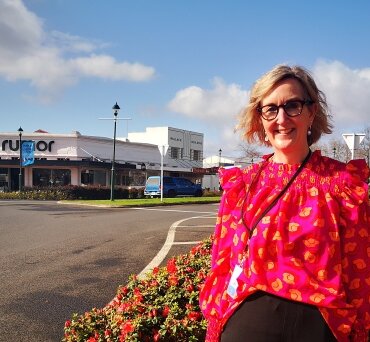

The architect of growth: Waipā’s Kirsty Downey has growth issues on her horizon as she leads the development of the district’s first spatial plan. Photo: Mary Anne Gill
Kirsty Downey understands why people’s eyes glaze over when she talks about Ahu Ake, Waipā’s spatial plan.
“We don’t want this to be a document that sits on the shelf,” says Downey, the council’s Strategy group manager and project owner.
And she is intent on ensuring the community, which even she says is in “consultation fatigue,” buys into the plan’s intent, to shape the district’s future.
“We want to hear from the community, we want them to be very much a part of this.”
Spatial planning will become an essential requirement of the Resource Management Act as it goes through a review, so Waipā is getting a head start on that.
It is a planning tool aimed at looking into the future by setting out various scenarios.
Downey’s team have presented five scenarios. The best parts of each will become the hybrid model, she says.
The first considers what is already in place through the council’s Long Term and District plans and the Future Proof strategy which is a 30-year growth management and implementation plan for Hamilton, Waipā and Waikato councils.
The other scenarios factor in other what ifs – like if the population grows more rapidly than expected or does not grow at all.
The planning is interactive, visual and spatial.
“The people who are working on this are really genuinely passionate about what we’re doing and why we’re doing it. We come with open hearts, putting our own personal touch to it too,” says Downey who describes what she is leading as “exciting.”
She was born in Gisborne and grew up in Te Kuiti where her father worked for the Social Welfare Department once, like many Government departments, an integral part of communities like Te Kuiti.
She studied law at Waikato University and then worked at Federated Farmers doing policy work.
Downey spent 19 years at Tauranga City Council, firstly in a legal and governance role and latterly in the executive wing.
In May 2019, she joined Waipā District Council as Strategy manager and moved her family to Cambridge. Following an in-house review, she became group manager of Strategy in March this year with responsibility for the Spatial Plan.
Behind the scenes, much has already been done, she says, including forming partnerships with mana whenua and iwi and adopting a district wide approach rather than community by community.
“Now we’re working with them to undertake the evaluation of (the) five possible scenarios.
“This plan will pull everything together and be our key strategic document.”
It will identify priority areas for future investment by the council, the government and developers and help shape business cases and projects.
“We represent our communities, and a big part of this spatial plan is what is good for our community.”
Covid highlighted the importance of community, says Downey.
A website has been launched which allows the public to check out the scenarios using a geographic information system (GIS) – a computer system for capturing, storing, checking and displaying data related to positions on Earth’s surface.
It shows many different kinds of data on one map, such as streets, buildings and vegetation and how population changes and development impacts on that.
In an earlier interview with The News, chief executive Garry Dyet identified growth as the biggest issue facing Waipā District Council.
Ahu Ake will be the result of local communities having their say, he said.










